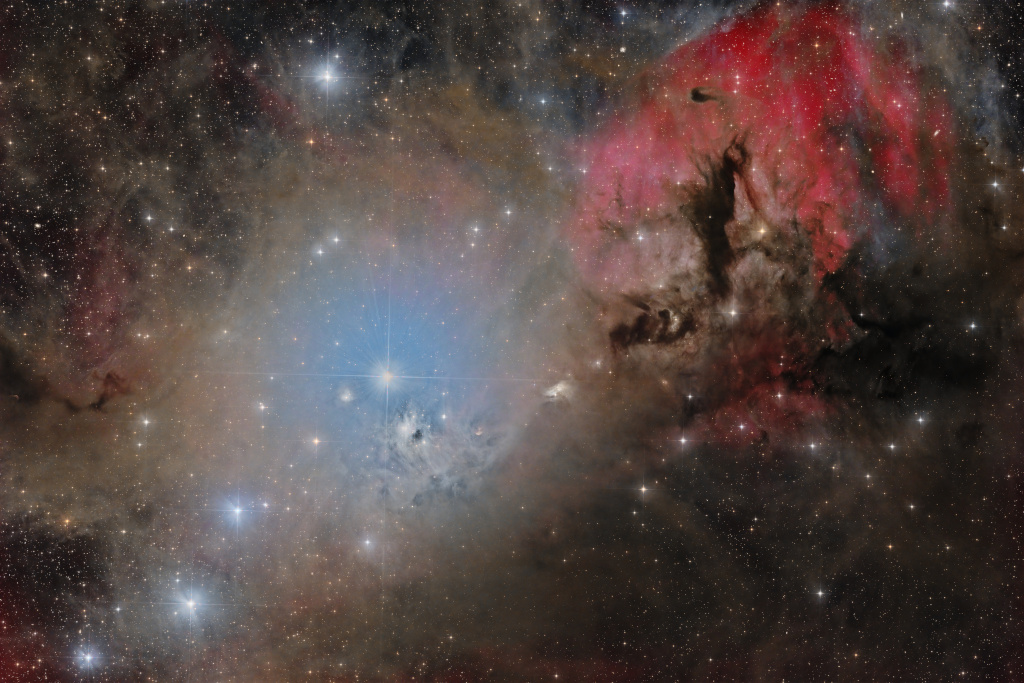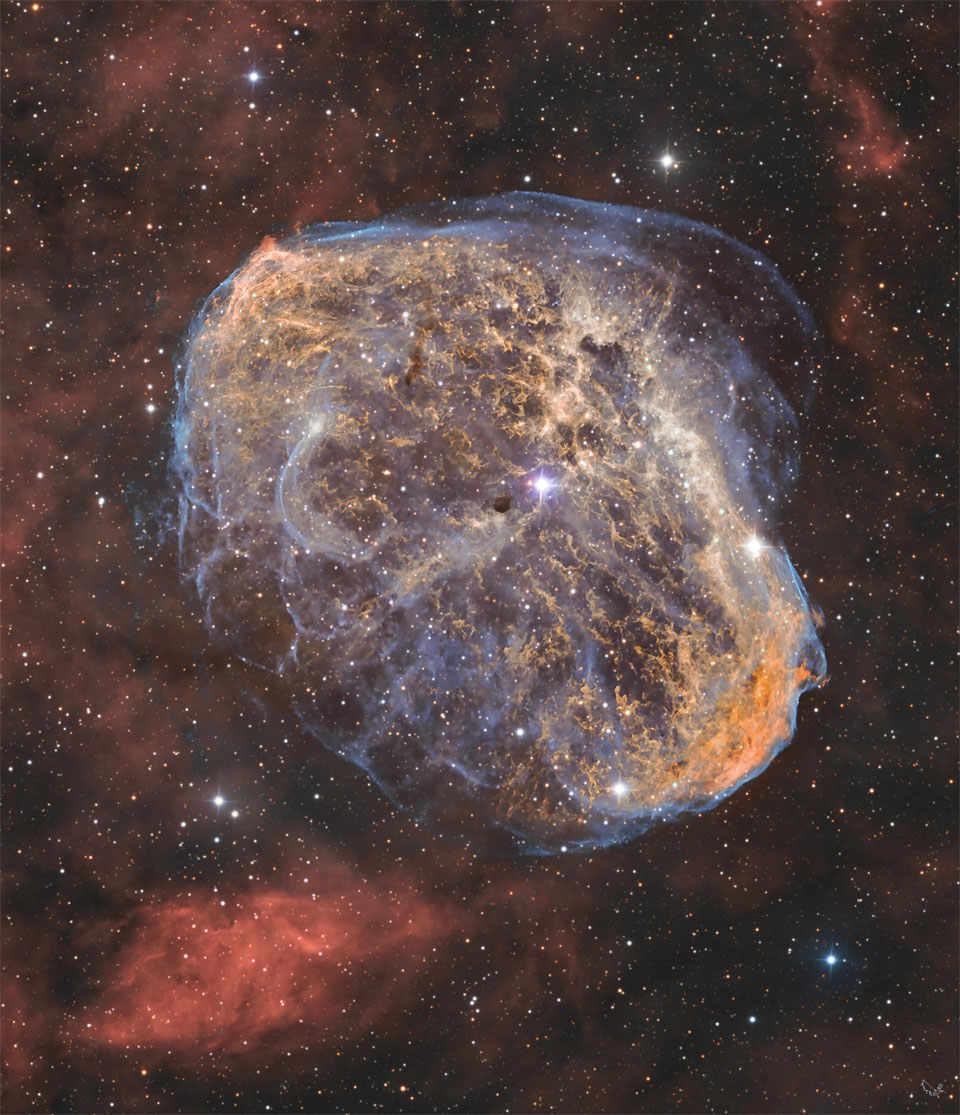Blog

A great nebulous region near bright star omicron Persei offers this study in cosmic contrasts. Captured in the telescopic frame the colorful complex of dust, gas, and stars spans about 3 degrees on the sky along the edge of the Perseus molecular cloud some 1000 light-years away. Surrounded by a bluish halo of dust reflected starlight, omicron Persei itself is just left of center. Immediately below it lies the intriguing young star cluster IC 348 recently explored by the James Webb Space Telescope. In silhouette against the diffuse reddish glow of hydrogen gas, dark and obscuring interstellar dust cloud Barnard 3 is at upper right. Of course the cosmic dust also tends to hide newly formed stars and young stellar objects or protostars from prying optical telescopes. At the Perseus molecular cloud’s estimated distance, this field of view would span about 50 light-years.

Yiannis Chryssomallis (Greek: Γιάννης Χρυσομάλλης; born November 14, 1954), known professionally as Yanni , is a Greek composer, keyboardist, pianist, and music producer.
Yanni continues to use the musical shorthand that he developed as a child, blending jazz, classical, soft rock, and world music to create predominantly instrumental works. Although this genre of music was not well suited for commercial pop radio and music television, Yanni received international recognition by producing concerts at historic monuments and by producing videos that were broadcast on public television. His breakthrough concert, Live at the Acropolis, yielded the second best-selling music concert video of all time.Additional historic sites for Yanni’s concerts have included India’s Taj Mahal, China’s Forbidden City, the United Arab Emirates’ Burj Khalifa, Russia’s Kremlin,[15] Puerto Rico’s El Morro castle, Lebanon’s ancient city of Byblos, Tunisia’s Roman Theatre of Carthage, India’s Laxmi Vilas Palace,[19]the Egyptian pyramids and Great Sphinx of Giza, and the Amman Citadel.
At least sixteen of Yanni’s albums have peaked at No. 1 in Billboard’s “Top New Age Album” category, and two albums (Dare to Dream and In My Time) received Grammy Award nominations. Yanni has performed in more than 30 countries on five continents, and through late 2015 had performed live in concert before more than 5 million people and had accumulated more than 40 platinum and gold albums globally, with sales totaling over 25 million copies. A longtime fundraiser for public television, Yanni’s compositions have been used on commercial television programs, especially for sporting events.He has written film scores and the music for an award-winning British Airways television commercial.
Yanni popularized the combination of electronic music synthesizers with a full symphony orchestra. He has employed musicians of various nationalities and has incorporated a variety of exotic instruments to create music that has been called an eclectic fusion of ethnic sounds. Influenced by his encounters with cultures around the world,Yanni has been called a “true global artist” and his music is said to reflect his “one world, one people” philosophy.
more...Stanley Dural Jr. (November 14, 1947 – September 24, 2016 Lafayette, LA), better known by his stage name Buckwheat Zydeco, was an American accordionist and zydeco musician. He was one of the few zydeco artists to achieve mainstream success. His music group was formally billed as Buckwheat Zydeco and Ils Sont Partis Band (“Ils Sont Partis” being French for “They have left,” or a race announcer’s “And they’re off!”), but they often performed as merely Buckwheat Zydeco.
The New York Times said: “Stanley ‘Buckwheat’ Dural leads one of the best bands in America. A down-home and high-powered celebration, meaty and muscular with a fine-tuned sense of dynamics…propulsive rhythms, incendiary performances.” USA Todaycalled him “a zydeco trailblazer.” Buckwheat Zydeco performed with famous musicians such as Eric Clapton (with whom he also recorded), U2 and the Boston Pops. The band performed at the closing ceremonies of the 1996 Summer Olympics to a worldwide audience of three billion people. Buckwheat performed for President Clintontwice, celebrating both of his inaugurations. The band appeared on the Late Show with David Letterman, CNN, The Today Show, MTV, NBC News, CBS Morning News, National Public Radio‘s Mountain Stage, and Late Night with Jimmy Fallon.
more...Aaron Copland (November 14, 1900 – December 2, 1990) was an American composer, critic, writer, teacher, pianist and later a conductor of his own and other American music. Copland was referred to by his peers and critics as the “Dean of American Composers”. The open, slowly changing harmonies in much of his music are typical of what many people consider to be the sound of American music, evoking the vast American landscape and pioneer spirit. He is best known for the works he wrote in the 1930s and 1940s in a deliberately accessible style often referred to as “populist” and which the composer labeled his “vernacular” style. Works in this vein include the ballets Appalachian Spring, Billy the Kid and Rodeo, his Fanfare for the Common Man and Third Symphony. In addition to his ballets and orchestral works, he produced music in many other genres, including chamber music, vocal works, opera and film scores.
After some initial studies with composer Rubin Goldmark, Copland traveled to Paris, where he first studied with Isidor Philipp and Paul Vidal, then with noted pedagogueNadia Boulanger. He studied three years with Boulanger, whose eclectic approach to music inspired his own broad taste. Determined upon his return to the U.S. to make his way as a full-time composer, Copland gave lecture-recitals, wrote works on commission and did some teaching and writing. However, he found that composing orchestral music in a modernist style, which he had adopted while studying abroad, was a financially contradictory approach, particularly in light of the Great Depression. He shifted in the mid-1930s to a more accessible musical style which mirrored the German idea of Gebrauchsmusik (“music for use”), music that could serve utilitarian and artistic purposes. During the Depression years, he traveled extensively to Europe, Africa, and Mexico, formed an important friendship with Mexican composer Carlos Chávez and began composing his signature works.
During the late 1940s, Copland became aware that Stravinsky and other fellow composers had begun to study Arnold Schoenberg‘s use of twelve-tone (serial) techniques. After he had been exposed to the works of French composer Pierre Boulez, he incorporated serial techniques into his Piano Quartet (1950), Piano Fantasy (1957), Connotations for orchestra (1961) and Inscape for orchestra (1967). Unlike Schoenberg, Copland used his tone rows in much the same fashion as his tonal material—as sources for melodies and harmonies, rather than as complete statements in their own right, except for crucial events from a structural point of view. From the 1960s onward, Copland’s activities turned more from composing to conducting. He became a frequent guest conductor of orchestras in the U.S. and the UK and made a series of recordings of his music, primarily for Columbia Records.
more...George Andrew Cables (born November 14, 1944 NY) is an American jazz pianist and composer.
Cables has played with Art Blakey, Sonny Rollins, Dexter Gordon, Art Pepper, Joe Henderson, and other well-established jazz musicians.
His own records include the 1980 Cables’ Vision with Freddie Hubbard among others.From 1983, Cables worked in the project Bebop & Beyond. He left later in the 1980s, but returned for guest appearances on two early 1990s albums, before rejoining in 1998.
Cables is a charter member of The Cookers band, founded in 2010, which includes leading jazz composers and players like Billy Harper, Eddie Henderson, David Weiss, Donald Harrison, Cecil McBee, Billy Hart and others.
more...Justine Washington (born October 13, 1940), usually credited as Baby Washington, but credited on some early records as Jeanette (Baby) Washington, is an American soul music vocalist, who had 16 Billboard R&B chart entries in 15 years, most of them during the 1960s. Her biggest hit, “That’s How Heartaches Are Made” in 1963, also entered the Top 40 on the Billboard Hot 100.
Washington was born in Bamberg, South Carolina, United States, and raised in Harlem, New York. In 1956, she joined the vocal group the Hearts, and also recorded for J & S Records as a member of the Jaynetts (“I Wanted To Be Free”/”Where Are You Tonight”, J&S 1765/6). She first recorded solo, as Baby Washington, in 1957, on “Everyday” (J&S 1665).
more...
Looking like an emerging space cocoon, the Crescent Nebula, visible in the center of the featured image, was created by the brightest star in its center. A leading progenitor hypothesis has the Crescent Nebula beginning to form about 250,000 years ago. At that time, the massive central star had evolved to become a Wolf-Rayet star (WR 136), shedding its outer envelope in a strong stellar wind, ejecting the equivalent of our Sun’s mass every 10,000 years. This wind impacted surrounding gas left over from a previous phase, compacting it into a series of complex shells, and lighting it up. The Crescent Nebula, also known as NGC 6888, lies about 4,700 light-years away in the constellation of Cygnus. Star WR 136 will probably undergo a supernova explosion sometime in the next million years.

Bill Gibson is an American drummer. Since 1979, he has been the drummer for Huey Lewis and the News. Since the band’s hiatus in 2020, he is currently a member of the Sons of Champlin.
Gibson was born in Sacramento to Edward and Phyllis Gibson. Gibson started playing the drums at age twelve. His father, Ed, was an architect, and played drums after finishing work for the day. He was influenced by Art Blakey and Buddy Rich. In 1967, his father took him to the Monterey Jazz Festival. He eventually acquired his first drum kit at fourteen, and as a teenager saw The Beatles twice, and The Dave Clark Five.
Bill joined Huey Lewis and the News as drummer in 1979. The News’ sound draws upon early pop, R&B, doo-wop, blue-eyed soul and new wave. They had many top ten hits in the 1980s, including “Do You Believe in Love“, “Heart and Soul“, “I Want a New Drug“, “The Heart of Rock & Roll“, “If This Is It“, “Hip to Be Square“, “I Know What I Like“, “Doing It All for My Baby” and “Perfect World“.
more...John Paul Hammond (born November 13, 1942) is an American singer and musician.
He is the son of record producer John H. Hammond, and is sometimes referred to as John Hammond Jr. in order to distinguish the two.
Hammond is a son of record producer and talent scout John H. Hammond and his first wife, Jemison McBride, an actress. He is a descendant of Cornelius Vanderbilt, the patriarch of the prominent Vanderbilt family, through his paternal grandmother Emily Vanderbilt Sloane Hammond. He has a brother, Jason, and a stepsister, (Esme) Rosita Sarnoff, the daughter of his father’s second wife, Esme O’Brien Sarnoff. Hammond’s middle name, Paul, is in honor of a friend of his father, the actor Paul Robeson. The younger Hammond was raised by his mother and saw his father only a few times a year while growing up.
He began playing guitar in high school, partially inspired by the album Jimmy Reed at Carnegie Hall. He attended Antioch College for one year but dropped out to pursue a music career. By the mid-1960s he was touring nationally and living in Greenwich Village. He befriended and recorded with many electric blues musicians in New York, including Jimi Hendrix, Eric Clapton, Levon Helm‘s New Hawks (later known as the Band), Mike Bloomfield, Dr. John, and Duane Allman.
more...Pascal-Emmanuel Sinamoyi Tabu (13 November 1940 – 30 November 2013),better known as Tabu Ley Rochereau, was a leading African rumba singer-songwriter from the Democratic Republic of the Congo. He was the leader of Orchestre Afrisa International, as well as one of Africa’s most influential vocalists and prolific songwriters. Along with guitarist Dr Nico Kasanda, Tabu Ley pioneered soukous (African rumba) and internationalised his music by fusing elements of Congolese folk music with Cuban, Caribbean and Latin American rumba. He has been described as “the Congolese personality who, along with Mobutu, marked Africa’s 20th century history.” He was dubbed “the African Elvis” by the Los Angeles Times. After the fall of the Mobutu regime, Tabu Ley also pursued a political career. His musical career ran parallel to the other great Congolese rhumba bandleader and rival Franco Luambo Makiadi who ran the band TPOK Jazz throughout the 1960s, 1970s and ’80s.
During his career, Tabu Ley composed up to 3,000 songs and produced 250 albums. In 2023, Rolling Stone ranked him at number 178 on its list of the 200 Greatest Singers of All Time.
more...Idris Muhammad (Arabic: إدريس محمد; born Leo Morris; November 13, 1939 – July 29, 2014) was an American jazz drummer and bandleader. He had an extensive career performing jazz, funk, R&B, and soul music and recorded with musicians such as Ahmad Jamal, Lou Donaldson, Pharoah Sanders, Bob James, and Tete Montoliu.
At the age of 14, Muhammad began his professional career by performing with The Hawketts on their iconic recording “Mardi Gras Mambo”. Two years later, in 1956, he played drums on Fats Domino’s recording of “Blueberry Hill“.
After being introduced by Joe Jones, Muhammad began touring with Sam Cooke. Later he played with Jerry Butler and Curtis Mayfield in Chicago, working largely in R’n’B, before moving to New York City in the mid-1960s. In New York, Muhammad became embedded in the jazz scene playing with Kenny Dorham, Horace Silver, Lou Donaldson and Betty Carter. He also played in the Apollo Theatre’s house band. In 1967, he accepted a job in the orchestra for the initial off-Broadway production of Hair and stayed with the production when it moved to Broadway.
more...
Hampton Barnett Hawes Jr. (November 13, 1928 – May 22, 1977 LA, CA) was an American jazz pianist. He was the author of the memoir Raise Up Off Me, which won the Deems-Taylor Award for music writing in 1975. Hawes was self-taught; by his teens he was playing with the leading jazz musicians on the West Coast, including Dexter Gordon, Wardell Gray, Art Pepper, Shorty Rogers, and Teddy Edwards. His second professional job, at 18, was playing for eight months with the Howard McGhee Quintet at the Hi De Ho Club, in a group that included Charlie Parker. By late 1947, Hawes’ reputation was leading to studio recording work. Early studio dates included work for George L. “Happy” Johnson, Teddy Edwards, Sonny Criss, and Shorty Rogers. From 1948 to 1952, he was recorded live on several occasions at Los Angeles-area jazz clubs including The Haig, The Lighthouse, and The Surf Club. By December 1952, he had recorded eight songs under his own name for Prestige Records with a quartet featuring Larry Bunker on vibraphone. Hampton Hawes died unexpectedly of a brain hemorrhage in 1977, at the age of 48.
more...
More Posts
- Blind Willie Johnson
- Flamenco Fridays with Antonio Campos
- Daily Roots with Coxsone Dodd
- Surviving the Pandemic and Realizing Racial Justice
- The Cosmos with M78
- Steve Gilmore
- Richie Havens
- Snooks Eaglin
- Juice Wilson
- World Music with WÖR
- Daily Roots with Fulk Livingston Reid
- Surviving the Pandemic and Realizing Racial Justice
- The Cosmos with M51
- Jeff Tain Watts
- Jimmy Cobb
- Leadbelly
- World Music with Duo Coincidencia
- Daily Roots with Bob Marley
- CONGRATULATIONS AMERICA Trumps Last Day in Office
- Surviving the Pandemic and Realizing Racial Justice